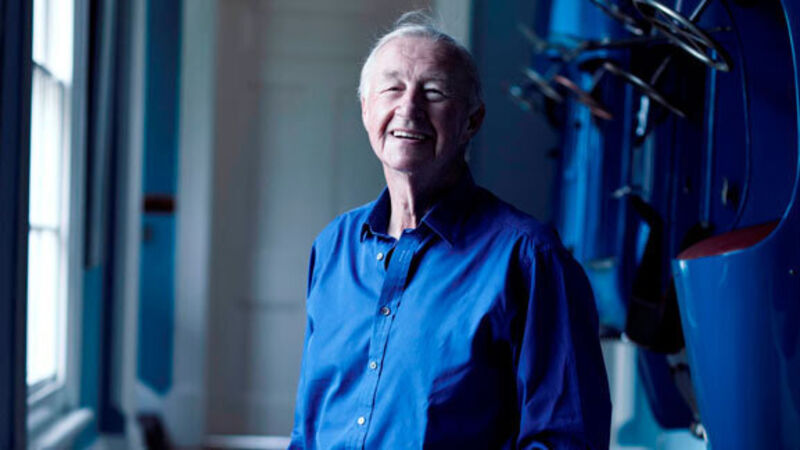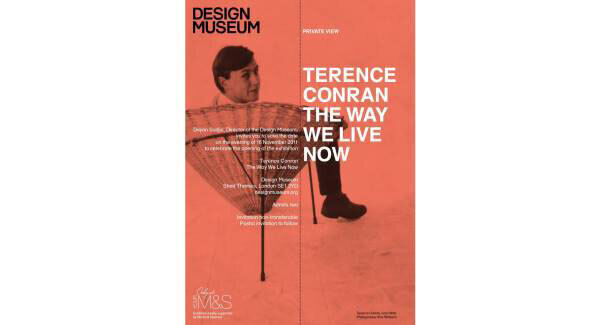Getting inside the mind of design genius Terence Conran

He does not understand holidays, currently wears only blue shirts made to measure by Hawes & Curtis and, since the 1950s, has almost single-handedly changed the way the British furnished their homes.
In 2014, Sir Terence Conran finally handed the reins of Conran Holdings to his son, fashion and interior designer, Jasper Conran. Rumours of feuding between the five gifted Conran siblings were firmly put to bed.
Comprising an urban, architectural and design practise, Conran & Partners, continues to develop its worldwide reputation and Terence Conran remains the symbolic head, social diplomat and design champion of the Conran group of companies.
Restaurants, French culinary goods, and Scandinavian style furnishings are the big three that come to mind at the mention of his name. However, Terence Conran entered my life, as he did many Irish householders, through his books.
The brick wall covered The House Book (Mitchell Beazley 1974) was a standard reference for my parents’ generation and, looking through my own shelves, I found I had five other Conrans, heavily thumbed with multiple post-it notes fluttering at the top edge, marking out designs for DIY shelving or some unexpected placement of pictures. He’s remained a blessed, easy read with insightful, economic advice.
The House Book was a seminal moment in the career of Conran, and the first of 50 volumes penned largely under the umbrella of his own publishing company, Conran Octopus.
Designed by Stafford Cliff, it was not simply a lush venture into chic contemporary roomscapes, but rather a mission statement.
It shifted groundbreaking home and interiors firm Habitat centre stage as a crucible of the desirable, affordable object. Narrated and edited by Conran, The House Book was a comfort object, with unassailable advice on what constituted good taste and aspirational modernity.
Since its first publication in 1974, every serious interiors firm has followed its lead in glossy seasonal bibles.
With a proven design record and unfailing instincts in the marketplace, Conran gave the lead, and he remains the celebrity retailer par excellence, proving that good design and best business practice could flourish together without shame.
His price point at Habitat was set at the salary of a British secondary school teacher.
This might sound condescending, but it flew at just the right level for what this renaissance in the interiors’ market could bear, and Conran saw the profession as forward-thinking beings, not flying too high or too low.
Terence Conran didn’t finish his third-level education — he was simply too busy. As a child, he had built balsa wood furniture for dolls’ houses, selling them to his sisters’ friends — an early flag of his precocious business sense.

Teacher, Don Potter, at his first school, Bryanston in Kent, gave him some elementary crafting skills. Charles Handley-Read, an important voice in contemporary architecture, also taught at the school and honed his eye.
In 1948, at the age of 17, he set up a workshop in the East End with his tutor at the Central School of Art and Design, print-maker Eduardo Paolozzi.
He was later engaged to build scale models for architect Dennis Lennon, to be used at the home, garden, and transport pavilions at the Festival of Britain in 1951. The Festival spoke of another world — of elastic European interiors, appliances to make chores melt and a wipe-clean shiny world to replace the dreary fug of post-war Britain.
The message was clear — new and better design led directly to a new and better life, and Conran trusted that, once made available, the British would embrace and buy directly into this concept.
Ornate decoration was now largely relegated to accents on modern furnishings, as it was seen to obscure, rather than enhance, the purity of a line.
In an introduction to one of his latest books (Plain Simple Useful 2014, Conran Octopus), he admits to running away to the servants’ quarter on visits to stately homes, as he simply enjoyed the spare styling of the things he found there, and calls this a reaction to the uncomfortable flash of ‘bankers’ style’.
However, Conran was never likely to forge a quiet career below stairs. Conran-style, comprised of his pieces and those promoted in the Conran Shop, are today another sort of trophy decorating even if far, far easier to look at than crenellated neo-Georgian.
The Festival of Britain was market-driven and, with messianic zeal, Conran concentrated on design that was worthy, popular and (crucially) swift to manufacture.
Dennis Lennon released him despite, or perhaps because of, clear signs of greater promise (he showed textiles and furniture in 1951). Conran immediately set up business, working out of a studio in Bethnal Green, designing, making and supplying his furniture designs to other London retailers.
This experience informed his future — to draw up things he knew that someone with equivalent skills could easily make in multiples.
A formidable designer consumed with the guiding light of Arts and Crafts, once lifted from the drawing board, his one good eye (one was lost to a lathe accident at 13), was trained on a piece’s potential success on the factory floor — and the high street.
It’s often said that Conran brought French cuisine to the English. — but truthfully, that credit lies with Elizabeth David.
He did at least wash dishes in Paris and, travelling around, was inspired by the benefits recognised in old Europe, that simple, perfectly-cooked food and easy living was good for the soul.
In his 2014 publication, Plain Simple Useful, the “elemental pleasures that we go on holiday to experience”, that vitality he believes is released by simplicity married to practicality and good
materials, has remained unchanged.
His personal energy as a business mogul juggling parallel interests and multiple firms is truly daunting. The inception of Conran’s restaurant collection in 1953 with the opening of the celebrated, understated gem, The Soup Kitchen, led him to open 50 more premises over the next six decades.
The first group of Conran’s Summa range of furniture appeared in 1956, in spare styling, well-constructed and quite typical Danish forms. Looking at the pieces today, there’s a continuous, recognisable distinction to Conran’s work which is now being rediscovered.
During this period he also designed the second Bazaar outlet for Mary Quant. And in 1964, when Habitat, his own shop, was launched on the King’s Road in Chelsea, clothes for the female staff were by Quant, and hairstyles by Vidal Sassoon.
A factory in Thetford in Norfolk gave employment to more than 80 families, who moved to the area to serve it.
Retail gave Conran ultimate control, freeing him from former frustrations at the confused, old-fashioned presentation of his products by other companies where he was inevitably sharing attention in the showroom.
Habitat’s wares included culinary tools never seen on the UK market before.
The chicken brick, Sabatier knives, the garlic press, Le Creuset, and the first domestic woks were novel, energising, introductions for his style-hungry audience.
A shopper might not be able to afford a designer table at Habitat, but they might pick up an iconic paper lantern while in store. By 1978, he had 18 Habitat shops across the country.
He’s credited with flat-pack furniture and blessed us with the enveloping joys of the continental duvet. (Ingvar Kamprad, founder of IKEA remains a close friend and eventually bought Habitat, but sold the brand again.)
The Conran Shop, founded in 1974 at Michelin House on the Fulham Road in Chelsea, (above), included slightly more luxurious objects that didn’t quite have a home at Habitat.
An ‘eclectic edit’ is how the firm is described today, showcasing innovative makers and classic mid-century patented goods together with Conran’s own in-house designers. Michelin House (c 1911) remains one of Conran’s favourite buildings, and he bought it outright in 1984. He describes opening Michelin House up again, as ‘the happiest day of my life’. For a time Conran would own Heals, Mothercare and BHS, and he helped to set up Next.
Flying so high, the falls were bound to be weighty and, in 1990, Conran lost control of Habitat (Storehouse PLC). Since 2011 it has been owned by the Home Retail Group which includes Argos and Homebase — its departure was deeply felt.
The Conran Shop with two flagship London stores, another in Paris and presences in high end department stores across the World (Japanese buyers have a special devotion to the quintessentially English brand), is still under the Conran Group.
An important exhibiion of Conran’s work in 2012, The Way We Live Now, at London’s Design Museum, (which he founded and supports), highlighted Conran’s deft delivery of his pieces to the customer. Bags, posters, catalogues, and books all played their part.
The museum itself, set to move from Conran’s stomping ground in Shad Thames to a fabulous new premises in Kensington, (opening in November), was conceived and funded by Conran as Boilerhouse at the V&A in 1982. Some of the money released by floating Habitat in 1981 was used to establish the Conran foundation which sought to bring the importance of industrial design to wider notice through education programmes and engaging exhibitions.
If you want a feeling of where Conran’s heart and mind is today, I would recommend his 2014 book, Plain Simple Useful or the latest, Colour by Conran (2015).
Conran raps out nuggets of interiors-speak that just make great sense and his overarching aesthetic, the look, has changed hardly at all. DIY project builds always had a place in his books, and most could be enjoyed by the anti-shopper who never puts a toe inside the Conran Shop.
His recent work, in 2011, for high street giant M&S, has clearly excited him over and beyond the rhetoric of any press release.
Terence spends much of his time today at Benchmark Furniture, working with a relatively young team of designers and craftsmen out of a barn at his home Barton Park in Norfolk. They serve private, corporate, public and high street clients and designed the Barton and Pavilion ranges for Ercol.
Co-founded in 1984 with cabinet maker Sean Sutcliffe, the studio workshop takes local planks in one end of their production line and turns out finished product at the other.
The firm holds regular clearance sales with hand-made dining tables in FSC timbers from around €4,000.
It is a return to Conran’s roots as a maker, and continues what he is most celebrated for since Habitat opened its doors half a century ago — the democratisation of good design.
Find Benchmark Furniture online at benchmarkfurniture.com. Brands from The Conran Shop can be found at Arnotts of Dublin. The Conran Shop delivers to Ireland. See conranshop.co.uk, and another range is available to browse online at www.contentbyterenceconran.com.










